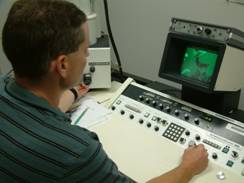Problem Solving
Abrasives
Touchstone assisted a manufacturer in developing a process for the recovery of the alloy-rich metal mixed with their grinding swarf.
The following examples illustrate some of our contributions to this business sector:

- A manufacturer of cast steel shot asked Touchstone to examine some of its product and determine the reason for excessive cracking. Chemical analysis was performed and all values met specification. Rockwell hardness values of 59C were also within specification. Metallographic cross-sections revealed that all of the cracking was occurring in long martensitic plates in the microstructure. Apparently, the metal was freezing in two stages. First, long martensite plates were formed, and when the remaining material transformed, it put high residual tensile stresses on the long plates of martensite – causing the unacceptable cracking.
- Touchstone assisted a manufacturer in developing a process for the recovery of the alloy-rich metal mixed with their grinding swarf. This reduced the waste output of the manufacturer while allowing re-use of alloy bearing metal that was otherwise sold to a smelting operation.
- A cut nail manufacturer reported excessive knife wear on nail cutting machines used in their nail manufacturing process. Touchstone performed a thorough metallographic examination of the samples and determined that a significant amount of mill scale still remained on the sheet material “after shotblast cleaning”. The presence of unremoved mill scale resulted in excessive knife wear because of its hardness. Changes in the shotblast procedure were suggested to increase the efficiency in the scale removal process.
- Evaluation of steel specimens: Portions of both steel specimens and an amount of the steel shot material were mounted in epoxy, abraded, polished and etched to allow a comparison of the microstructure of several of the inclusions to the steel shot. Touchstone concluded that the inclusions consisted of steel shot particles, which have been rolled into the surface during the cold rolling process.
- In related work, Engine oil samples were provided for evaluation that contained debris from a recent rebuild. Using EDS analysis of individual debris particles it was possible to demonstrate that most of the foreign material originated in alumina abrasives used in the rebuild.
- Catastrophic failure of a spline shaft on an electric motor was traced to abrasive wear by fretting of the splines. Once wear had become great enough to allow free play the splines began to break away under starting loads. The source of the failure was assigned to improper fit during original manufacture of the parts.
The above examples are only a sample of our work in this area. We would be pleased to provide any additional information you may require. We also invite you to review examples on our website of work that we have performed in support of other business sectors.
Please contact one of our Project Managers to discuss your manufacturing problem. We would welcome an opportunity to add you to our rapidly growing list of satisfied customers.
More Example Reviews
To review more examples, please select from the following menu:

